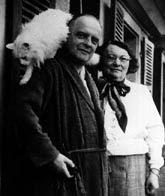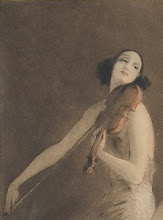Paul Klee was born in Münchenbuchsee near Bern. His father, Hans Klee and his mother Ida Maria Frick were musicians; and Klee himself was a talented violinist.
Klee studied drawing and painting in Munich for three years (1898–1901). In 1911 he became involved with the German Expressionist group Der Blaue Reiter (The Blue Rider), founded by Wassily Kandinsky and Franz Marc. Klee and Kandinsky were lifelong friends. Although Klee worked in relative isolation, experimenting with various styles and media. His work was influenced by the Cubism of Pablo Picasso and Georges Braque, and the abstract translucent color planes of Robert Delaunay.
Paul Klee 'Hermitage' 1918, watercolor
Paul Klee
Paul Klee - Southern (Tunisian) Gardens, 1919
In 1920 Klee was invited to join the faculty of the Bauhaus - the school of architecture and industrial design functioning first in Weimar (1919–25) and then Dessau (1925–32) where he taught 10 years. In 1931 Klee started teaching painting at the Academy of Fine Arts in Düsseldorf. In 1933, Paul Klee was defamed by the Nazi regime as a “degenerate artist”, and left Düsseldorf to immigrate to Bern with his wife Lily Klee-Stumpf. His son Felix Klee (born 1907), a theatre and opera director, remains in Germany, together with his wife Euphrosine Klee-Grejowa. Personal hardship and the increasing gravity of the political situation in Europe are reflected in the somber tone of his late work.
Last Still Life, 1940. This painting was among those left in the artist’s Bern studio in Kistlerweg after his death. Felix Klee, son of Paul Klee, retrospectively called it »Das letzte Stilleben« [The last still life], a description which has become its title.
Paul Klee 'Around the Fish'
Paul Klee’s body of work is a biography in pictorial form – even if many of his communications are coded and raise more questions than they answer. On closer examination, however, what becomes clear is the large extent to which Klee’s oeuvre is imbued with his character, his life circumstances and his environment. His works demonstrate his fondness for the satirical and the grotesque, his artistic experiments involving Expressionism and Constructivism, the Bauhaus and Picasso, and also his need for success and respect.
Klee, always the individualist, made efforts to assert himself and preserve his personal perspective on art. Klee was a refractory artist, who armed himself with irony and keen powers of observation against his environment and integrated biting commentary into his pictures. He was a philosopher, but he was also punctilious and strategic, and, for all his spirituality, he kept a strict eye on his public career.
Paul Klee
There are a good 4,000 works by Paul Klee stored in the Art Depository of the Zentrum Paul Klee in Bern (the Centre of Paul Klee) - the world’s most important collection of paintings, water colours and drawings by this artist. The special sensitivity of the work by Klee also prevents the Zentrum from staging a classic exhibition of the collection, with the same works on display all the time. The fragile condition of Paul Klee’s paintings is attributable to the artist’s particular method of working. He was not only content-related and formal in his approach, but also very keen on technical experimentation and used extremely light sensitive colours, paints and papers. If they were to be over-exposed to light – despite the subdued lighting in the exhibition rooms and the protective glazing used – the colours would gradually fade or change and the papers become brown or brittle.
"I cannot be understood at all on this earth. For I live as much with the dead as with the unborn. Somewhat closer to the heart of creation than usual. But not nearly close enough." These words were later used as Klee's epitaph. (Paul Klee : His Work and Thought (1991) by Marcel Franciscono)
Paul Klee - Botanical Theatre
Cosmic Composition, 1919
Paul Klee - The Black Prince, 1927
Paul Klee - Fruit on Red
Paul Klee - Landscape with Yellow Birds
Paul Klee - Temple Gardens
Paul Klee - Domes
Paul Klee - Viaducts
Paul Klee Heroische Rosen, 1938
Paul Klee - Ancient Sound 1924
Paul Klee - Attrapen (Omega 5) 1927
Paul Klee - The Golden Fish 1925




























1 comment:
Paul Klee is very good "mattmentalistic" guy. WOW. by Rene Jimeno. on FB.
Post a Comment